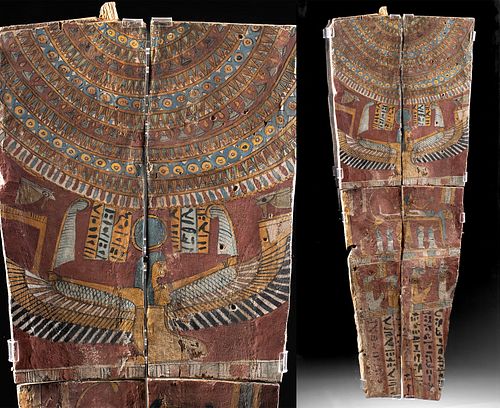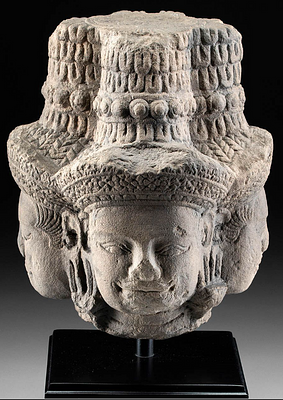Egyptian Polychrome Wood Sarcophagus Panel
About Seller
686 S Taylor Ave, Ste 106
Louisville, CO 80027
United States
Selling antiquities, ancient and ethnographic art online since 1993, Artemis Gallery specializes in Classical Antiquities (Egyptian, Greek, Roman, Near Eastern), Asian, Pre-Columbian, African / Tribal / Oceanographic art. Our extensive inventory includes pottery, stone, metal, wood, glass and textil...Read more
Two ways to bid:
- Leave a max absentee bid and the platform will bid on your behalf up to your maximum bid during the live auction.
- Bid live during the auction and your bids will be submitted real-time to the auctioneer.
Bid Increments
| Price | Bid Increment |
|---|---|
| $0 | $25 |
| $300 | $50 |
| $1,000 | $100 |
| $2,000 | $250 |
| $5,000 | $500 |
| $10,000 | $1,000 |
| $20,000 | $2,500 |
| $50,000 | $5,000 |
| $100,000 | $10,000 |
| $200,000 | $20,000 |
About Auction
Jun 29, 2023
Artemis Fine Arts info@artemisfinearts.com
- Lot Description
Ancient Egypt, Late Dynastic Period, 26th to 31st Dynasty, ca. 664 to 332 BCE. A hand-carved wooden panel, likely cedar, from the top of a sarcophagus. The tapered panel is comprised of 4 portions, each covered in gesso and painted with vibrant hues of red, blue, white, yellow, black, and seafoam green. Decorating the top half is a grand wesekh pectoral collar laden with painted beads of myriad forms while below is a pair of wadjet eyes, 6 columns of hieroglyphs, and a winged Isis kneeling and holding 2 feathers of Maat. The lower half shows Anubis presiding with ointment jar in hand over the body of the deceased, their organs contained in 4 canopic jars below the leonine table, and below is a procession of kneeling deities and 6 additional columns of hieroglyphs. Size (panel): 15.4" W x 42" H (39.1 cm x 106.7 cm); (case): 3" L x 24" W x 52" H (7.6 cm x 61 cm x 132.1 cm)
Interestingly, cedar wood was not native to Egypt. Egypt did not have verdant forests filled with tall trees, and unfortunately most of its native lumber was of relatively poor quality. Thus, they relied on importing to acquire hardwoods - ebony imported from Africa, cedar and pine from Lebanon. One fabulous obelisk inscription by Thutmose III attests to the luxury of treasured hardwoods. It reads as follows, "They brought to me the choicest products...consisting of cedar, juniper and of meru wood...all the good sweet woods of God's Land."
The rarity of cedar meant that coffin panels like this example were reserved for those who could afford them.
Anubis, based on the real animal called the African golden jackal, is a god associated with mummification and the afterlife and is usually depicted as either a canine or a man with a canine head. Like many Egyptian deities, the role of Anubis changed over time. During the First Dynasty, he was a protector of graves and an embalmer. In the Middle Kingdom period, Osiris claimed Anubis' role as lord of the underworld, but Anubis continued to weigh the hearts of the dead against a feather of truth to determine if they were deserving of eternal life.
Provenance: ex-John Hurter collection, Palm Springs, California, USA, purchased in Hong Kong in the mid-1980s and imported into the US prior to 1995
All items legal to buy/sell under U.S. Statute covering cultural patrimony Code 2600, CHAPTER 14, and are guaranteed to be as described or your money back.
A Certificate of Authenticity will accompany all winning bids.
We ship worldwide and handle all shipping in-house for your convenience.
#178902Condition
Repairs to some of the panel portions with chips and adhesive residue along break lines. Panel portions are glued heavily to lateral acrylic slats on the verso and are not attached to one another; panels cannot be removed from acrylic without damage. Restoration to some painted decorations, with chipping and fading to original pigment, and expected desiccation and chipping to wood. Nice preservation to original decorations. Has not been examined outside of acrylic case.
- Shipping Info
-
All shipping is handled in-house for your convenience. Your invoice from Artemis Gallery will include shipping calculation instructions. If in doubt, please inquire BEFORE bidding for estimated shipping costs for individual items.
-
- Buyer's Premium



 EUR
EUR CAD
CAD AUD
AUD GBP
GBP MXN
MXN HKD
HKD CNY
CNY MYR
MYR SEK
SEK SGD
SGD CHF
CHF THB
THB



















